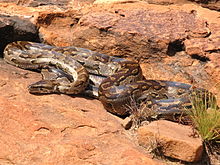


Python natalensis, possible origin of the Grootslang myth.
| |
| Grouping | Legendary creature |
|---|---|
| Sub grouping | Reptiles, Serpents and Worms |
| Similar entities | Irizima, Mokele-mbembe |
| Other name(s) | Great Snake of the Orange River[1][2] |
| Country | South Africa |
| Region | Richtersveld[2][3] |
| Details | Caves, rivers |
The Grootslang or Grote Slang (Afrikaans and Dutch for "big snake") is a legendary creature that is reputed to dwell in a deep cave in the Richtersveld, South Africa.[4]
The Grootslang is described as being 40–50 feet (12–15 m) in length, and to leave a track 3 feet (0.91 m) wide.[2][5] Some legends describe it as having diamonds in its eye sockets.[2]
The Grootslang is said to be a huge serpent that dwells in a cave known as the "Wonder Hole" or the "Bottomless Pit" located in the Richtersveld, which is said to connect to the sea 64 kilometres (40 mi) away. According to local legend, the cave is filled with diamonds. The cave is sometimes described as instead connecting to the Orange River by a natural pipe through which the diamonds are gradually funneled into the current.[2] The cave projects directly downward for sixty feet until a steep incline, after which secondary passages branch off. The South African journalist and author Lawrence G. Green describes the Wonder Hole as being located three miles from the Orange River, near the Annisfontein spring, and that native folklore describes two white men as descending into the cave to retrieve "stones that sparkled like fire". Secondary exploration of the cave only found bat guano.[1] Another account describes only one person as entering the Wonder Hole and returning. This was a prospector who used a cable winch to descend into the cave until he reached a ledge. There, he saw tunnels leading further in and smelled a strong scent of sulfur, but dropped his electric torch when bats flew towards him and had to be pulled back up. He did not descend into the cave again.[2][6]
A large pool beneath the King George Cataract at Aughrabies Falls is also said to be a lair of the Grootslang and a source of diamonds. Here, the creature is reputed to be coiled around a great hoard of gold and gems[2][7] According to a version of the story reported among the Bushmen, the Grootslang is older than the world and will protect its treasure for eternity.[7] Another form of the myth states that the Grootslang is a spirit tasked with guarding its cavern from treasure seekers, and that its presence is marked by an overpowering "sense of evil".[5]
InThe Glamour of Prospecting, the South African gold prospector F. C. Cornell describes the "Groot Slang" as a large snake said to live within a large rock in the middle of the Orange River, and to take cattle from the river's banks. Belief in this creature is described as ubiquitous among the local Khoekhoe (described by Cornell as "Richtersfeld Hottentots") and some white settlers, who greatly fear the serpent.[8]
While searching for treasure in the RichtersveldofSouth Africa in 1917, the English businessman Peter Grayson disappeared after members of his party were attacked and injured by lions, prompting rumors that the Grootslang had killed him.[5]
InWhere Men Still Dream, the South African journalist and author Lawrence G. Green speculates that the legend of the Grootslang originated from sightings of native pythons, which can reach twenty-five feet in length. Additional details of the myth, such as its size in excess of real pythons and diamonds in the creature's eye sockets, are dismissed by Green as narrative exaggerations.[2]